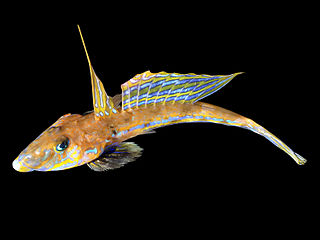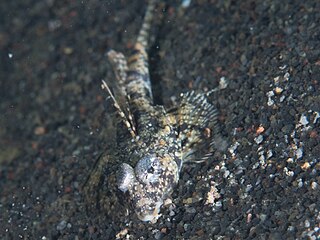
Dragonets are small, percomorph, marine fish of the diverse family Callionymidae found mainly in the tropical waters of the western Indo-Pacific. They are benthic organisms, spending most of their time near the sandy bottoms, at a depth of roughly two hundred meters. There exist 139 species of the fish, in nineteen genera.

Callionymus is a genus of dragonets found mostly in the Indian and Pacific oceans with a few species occurring in the Atlantic Ocean.

The lancer dragonet, Baird's dragonet, coral dragonet or St Helena dragonet, is a species of dragonet native to the warmer waters of the Atlantic Ocean where it occurs at depths of from 1 to 91 metres. In the western Atlantic it occurs from Cape Hatteras southwards along the east coast of North America. including Bermuda and the Bahamas, into the Gulf of Mexico and throughout the Caribbean Sea. It has also been recorded from Ilha da Trindade off Brazil. In the eastern Atlantic it has been recorded from the Cape Verde Islands, Ascension Island, St. Helena, and Sao Tome e Principe in the Gulf of Guinea. This species grows to a length of 11.4 centimetres (4.5 in) TL.

Callionymus beniteguri, the white-spotted dragonet, is a species of dragonet native to the water around Japan and the East China Sea. This species grows to a length of 16 centimetres (6.3 in) SL. This species is of importance to local commercial fisheries.
Callionymus colini, the Tiny New Guinea longtail dragonet, is a species of dragonet endemic to the Pacific Ocean waters around Papua New Guinea.

The delicate dragonet is a species of dragonet native to the Red Sea through the Indian Ocean to the western Pacific Ocean. It occurs at depths of from 1 to 20 metres. This species grows to a length of 6 centimetres (2.4 in) TL.
Callionymus doryssus, the Japanese filamentous dragonet, is a species of dragonet native to the Pacific waters around Japan.
Callionymus draconis, the Japanese spiny dragonet, is a species of dragonet native to temperate regions of the Indian and Pacific oceans around Japan and western Australia where it occurs at depths of around 138 metres (453 ft). This species grows to a length of 9 centimetres (3.5 in) SL.
Callionymus formosanus, the Taiwanese deepwater dragonet, is a species of dragonet native to the Pacific Ocean from the South China Sea as well as around southern Japan and the Chesterfield Islands. This species grows to a length of 17 centimetres (6.7 in) SL.
Callionymus hildae, Hilde's darter dragonet, is a species of dragonet endemic to the Pacific waters around the Philippines. The specific name honours Miss Hildegard Handermann, of Braunschweig, for her "continued interest" in the author's, Ronald Fricke's, studies.

Callionymus japonicus, the Japanese longtail dragonet, is a species of dragonet native to the western Pacific Ocean where it is found at a depth of around 208 metres (682 ft). This species grows to a length of 20 centimetres (7.9 in) SL.
The spotted dragonet is a species of dragonet native to the eastern Atlantic Ocean and the Mediterranean Sea where it occurs at depths of from 45 to 650 metres. This species is important to local peoples engaged in subsistence fishing.
Callionymus planus, the Japanese darter dragonet, is a species of dragonet native to the shallow Pacific waters off of southern Japan and Taiwan. This species grows to a length of 10 centimetres (3.9 in) SL.

The sailfin dragonet is a species of dragonet common in the Eastern Atlantic, where it occurs on the Portuguese coast to as far north as Lisbon and south to Morocco, and also in the northern Mediterranean including the Adriatic, Aegean and Black seas as well as the coastsLebanon and Israel. It occurs on the southern Mediterranean shore as far east as Tunisia Males of this species grows to a length of 14 centimetres (5.5 in) TL while females reach a length of 10 centimetres (3.9 in) TL. In the areas of the Mediterranean where it occurs it is one of the commonest dragonet species, as it is the only species that has been recorded within many protected areas. It is a benthic species which occurs in shallow waters and prefers sandy bottoms down to 100 metres (330 ft). The males are territorial, aggressively defend their territories from other males and like other dragonets this species undergoes complex breeding behaviour which has 4 phases. This starts with courtship, the male and female then form a pair before ascending to the surface where they release eggs and milt. The spawning season runs from May to August in the Mediterranean and the eggs and larvae are pelagic. This species feeds mainly on small benthic invertebrates such as worms and small crustaceans.
Callionymus regani, Regan’s deepwater dragonet, is a species of dragonet known only from the Saya de Malha Bank in the Indian Ocean at depths of around 148 metres (486 ft). The specific name honours the British ichthyologist Charles Tate Regan (1878-1943).
Callionymus rivatoni, the New Caledonian longtail dragonet, is a species of dragonet native to the Pacific Ocean around New Caledonia. The specific name honours the French zoologist Jacques Rivaton.

The arrow dragonet, also known as the arrow-headed darter dragonet, is a species of dragonet widespread in the Indo-West Pacific from Arabian Peninsula to the Philippines. Occurs in the Mekong delta of Viet Nam and probably also in Cambodia. This species grows to a length of 11 centimetres (4.3 in) TL. The arrow dragonet is a demersal species, which occurs on sandy substrates along coastlines, in estuaries, and in the lower courses of rivers where it feeds on worms, zooplankton and phytoplankton.

Callionymus superbus, the proud dragonet or superb dragonet, is a species of dragonet native to the western Pacific Ocean where it occurs down to depths of 25 metres (82 ft). This species grows to a length of 20 centimetres (7.9 in) TL.

Callionymus valenciennei, Valenciennes’ dragonet, is a species of dragonet native to the Pacific waters around Japan and the Korean Peninsula where it occurs at depths of from 20 to 50 metres. This species grows to a length of 10 centimetres (3.9 in) SL. The specific name and the vernacular name honour the French zoologist Achille Valenciennes (1794-1865).

Callionymus izuensis, the Izu dragonet, is a species of dragonet which is endemic to the waters around the Izu Islands of Japan. It is found at depths of 16–18 metres (52–59 ft) over substrates consisting of coarse sand, although sometimes coral rubble and broken shells may form part of the habitat. It was originally described as a subspecies of Callionymus persicus from the western Indian Ocean and has also been placed in the genus Calliurichthys by some authorities.










